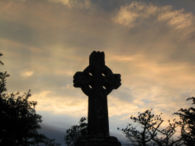Yesterday I presented a brief history of the soil which gave birth monasticism (Click to read Part 1). In short, the monastics chose a life self denial, isolation and rigorous spiritual disciples out of faithful devotion to Jesus. While the movement often withdrew from society (whether individually or communally) they offered a prophetic call to the low-committment Church of the Roman Empire. For the monastics, being a Christian wasn’t a transaction or a label, it was a way of life.
We have much to learn from the monastics, but how can we take what we have learned and shape communities that aren’t only focused on formation, but also mission?
The Missional Stream of Missional-Monastic Community
Although the monastery was—and to some degree still is—a place that is primarily focused on personal and communal formation through a withdrawal from culture, it largely served as the birthplace of the missional movement

within Church history. St. Patrick and his successors began to plant seeds of the missional DNA within the soil of monasticism and the Church in the fifth century. Having been kidnapped and enslaved by the Irish as a youth, Patrick returned home to Britain with a divine conviction to return to Ireland and invite his persecutors into the way of Jesus.
Not content to withdraw from society for the sake of personal formation, Patrick birthed a new form of monastery— what George G. Hunter III terms “monastic communities”. Unlike previous monasteries, Patrick’s weren’t “organized to protest and escape from the materialism of the Roman world and the corruption of the Church; the Celtic monasteries were organized to penetrate the pagan world and to extend the Church.” These communities were committed to spiritual formation—both individually and communally—and they were fueled by the missio dei to be good news in their new and extremely different context. They were what I see as missional-monastic communities.
Throughout our Christian history, the church often struggled to consistently produce missional-monastic communities, communities that were committed to internal formation that directly influenced their external extension and engagement. The institutions often calcified, the monasteries often withdrew at the expense of missional engagement, and missions turned to violent colonialism.
Obviously the news isn’t all bad as the Spirit faithfully led and guided the changing Church through its dysfunctions as it continues to do today. With that said, I think these paradigms remain a helpful critique and corrective for the Church. It is not enough to be purely focused on formation or purely focused on mission. There must be a dynamic interdependence that allows the Spirit to shape and fuel both individuals and communities as they seek to faithfully participate in the missio dei.
How often do our faith communities amount to little more than Bible studies? Can the Bible be faithfully “studied” if it isn’t put into practice in the “classroom” of our neighborhood, city, or world?
In contrast, how often do we go on mission trips where we don’t really have any relationship with the people we are seeking to serve or any understanding of the context in which they live? We have plenty of “outreach” programs, but our relationships with God and with neighborhoods are nothing more than a passing wave.
We can neither remain withdrawn from society in our monasteries nor advance on mission without being fueled by the Spirit. So what does it look like to be a missional-monastic community today in the unique soil of our context?
Tomorrow — Part 3: Embodied Missional-Monastic Community
The majority of this post is an excerpt from my book (with Rob Yackley) Thin Places: Six Postures for Creating and Practicing Missional Community, published by The House Studio

Great stuff, Jon!
I would probably change the word “relationship” in your second last question/paragraph for “discipleship”. My observation of STTs (short-term teams) is that they can be very good at making friends and building relationships but there’s little to no God encounter or discipleship going on.